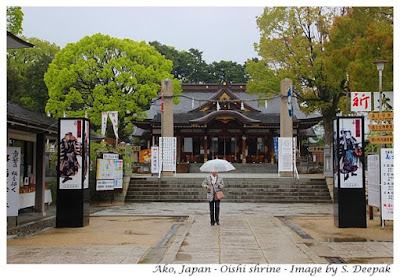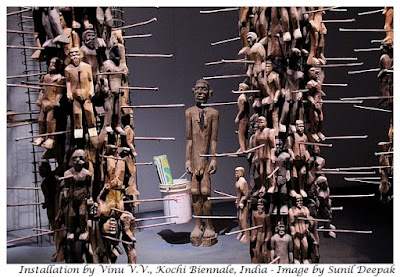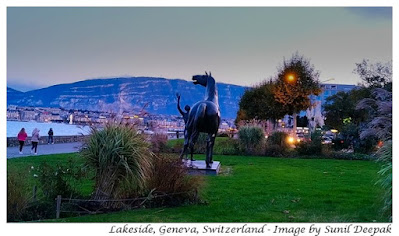Over the past couple of centuries, it seems that we have started a whitening process of our dark-skinned Gods, much like our craze for the whitening creams. If not fair, they are shown as light blue or green coloured figures, as the figure of lord Ram in the picture above. In plays and films, light-skinned actors are taken to play their roles.
For the past 10 days we are closed in our homes because of the Corona virus epidemic. Schio, the tiny town at the foothills of Alps mountains in the north-east of Italy where we live, has been largely spared from this epidemic so far. Thus, I have a lot of time to think and write for my blog! This was how I started to think about the popular Gods of Hinduism and ask myself, why are they shown as dark-skinned?
It sounds like a linear and clear explanation, and seems quite plausible. However, I find it difficult to place the black-skinned Gods of Hinduism in this narrative.
Two of the most popular deities of Hinduism - Ram and Krishna, both known as incarnations of Vishnu, are described as dark-skinned. Krishna's name, itself means black/dark. On the other hand, most of their consorts, the female deities, are described as fair skinned, except for Kali, one of the female deities associated with Shiva.
Vedic culture has been characterised as a Patriarchal Society - why did a Patriarchal Society choose low-in-hierarchy black-skinned figures as their male deities? One explanation can be that ancient Indians who believed in Vedic culture were themselves dark-skinned persons (or were a mixed group, somewhat like today's Indians, and dark-skinned persons among them had high-prestige roles) and that is why they preferred dark-skinned deities. If we accept this idea, what does that mean for the Aryan-Dravidian theories, as well as, for the caste theories?
For the past 10 days we are closed in our homes because of the Corona virus epidemic. Schio, the tiny town at the foothills of Alps mountains in the north-east of Italy where we live, has been largely spared from this epidemic so far. Thus, I have a lot of time to think and write for my blog! This was how I started to think about the popular Gods of Hinduism and ask myself, why are they shown as dark-skinned?
Dominant Narratives
For the past couple of centuries, the dominant narrative about ancient Indians and Hindus in India has been that of lighter-skinned Aryans, who had come from central or west Asia, and who pushed the darker skinned original inhabitants of India to the south or in the forests. Some even believe that they were invaders, who had destroyed the Indus Valley civilisation. However, that invasion theory is not considered now because no evidence had been found of widespread violence and war in the archaeological explorations in the Indus Valley.It sounds like a linear and clear explanation, and seems quite plausible. However, I find it difficult to place the black-skinned Gods of Hinduism in this narrative.
Why Did Aryans Choose Black Gods?
The question which I ask is this - if Vedic Hinduism was brought by light-skinned Aryans, who had come to dominate India and had pushed many indigenous groups to the margins of the societies, why did they choose so many dark-skinned Gods as their principle deities?Two of the most popular deities of Hinduism - Ram and Krishna, both known as incarnations of Vishnu, are described as dark-skinned. Krishna's name, itself means black/dark. On the other hand, most of their consorts, the female deities, are described as fair skinned, except for Kali, one of the female deities associated with Shiva.
Possible Explanations
According to a Hindi article I found on the internet, the black colour of Hindu deities was a philosophical choice because the black colour is formed by mixing of all the colours and thus it has all shades of the Prakriti (nature) in itself. However, I find it difficult to accept this explanation, because it seems like a more cerebral answer and does not say anything about the ideas and attitudes of the common persons, who needed to pray to those deities.Vedic culture has been characterised as a Patriarchal Society - why did a Patriarchal Society choose low-in-hierarchy black-skinned figures as their male deities? One explanation can be that ancient Indians who believed in Vedic culture were themselves dark-skinned persons (or were a mixed group, somewhat like today's Indians, and dark-skinned persons among them had high-prestige roles) and that is why they preferred dark-skinned deities. If we accept this idea, what does that mean for the Aryan-Dravidian theories, as well as, for the caste theories?
Another explanation can be that the ancient Vedic Indians believed in the mother-goddess and female deities, while the dark-skinned male deities belonged to Indus Valley people and indigenous people of the forests. When Aryans arrived and gradually assimilated with pre-existing Indian groups, they took over the pre-existing male deities. Thus, the dark-skinned deities came to Hinduism from the indigenous people of India, as the two groups assimilated and inter-mixed their deities.
Yet, another explanation can be that the principle deities of Hinduism arose as representations of the natural forces, and thus deities representing dark forces such as clouds and thunder, took on dark colours. But this logic does not seem to apply to the figures of Ram and Krishna.
Yet, another explanation can be that the principle deities of Hinduism arose as representations of the natural forces, and thus deities representing dark forces such as clouds and thunder, took on dark colours. But this logic does not seem to apply to the figures of Ram and Krishna.
Can you think of any other explanation about the dark-skinned deities of Hinduism?
Whitening of the Dark Gods
I am not sure when exactly did we start whitening our deities. One way can be to look at the Hindu deities in countries like Indonesia and Vietnam. Hinduism is supposed to have travelled to places like Bali in Indonesia and Champa in Vietnam in first-second century CE. Do they have any dark-skinned Hindu deities in these countries discovered in the archaeological excavations? If yes, that will help us in dating the choice of dark-skinned deities.We can also look at the probable dates when our epics like Ramayan were written, because Ramayan describes Ram and his youngest brother Shatrughan as dark-skinned, while the two other brothers, Laxman and Bharat, are described as fair-skinned. However, the claims about probable dating of Ramayan are very variable.
According to David Kinsley, "The Vamana Purana has a different version of Kali's relationship with Parvati. When Shiva addresses Parvati as Kali, "the dark blue one," she is greatly offended. Parvati performs austerities to lose her dark complexion and becomes Gauri, the golden one. Her dark sheath becomes Kausiki, who while enraged, creates Kali."
Vamana Purana is a late text, it has been dated to 9-11th century. Thus, this could mean that by 9-11th centuries, Hindus had started whitening its deities or at least to make them seem less dark? Or perhaps the Kali-Parvati story has other origins and looking for explanations based on a predilection for fair skins is misplaced and over-simplification of this issue.
In the second half of 19th century, Raja Ravi Varma popularised the Indian deities through his calendar art, where all the dark-skinned deities were shown either in light blue or fair-skinned. Those calendars had a huge influence and continue to affect how we imagine our Gods even today.
In the second half of 19th century, Raja Ravi Varma popularised the Indian deities through his calendar art, where all the dark-skinned deities were shown either in light blue or fair-skinned. Those calendars had a huge influence and continue to affect how we imagine our Gods even today.
Devdutt Pattnaik in his article - Black Gods and White Gods, had written about this Indian fascination for the fair skins, with the following words:
And so we had gods who were always pink, demons who were always brown and dark gods who were always blue. Indra, Brahma and Durga were pink, Asuras and Rakshasas were brown. Vishnu, Ram and Krishna were blue. Somehow, an unnaturally blue Krishna was preferred over a naturally dark Krishna. ‘Because blue is the color of the sky, of ether, of divinity,’ we were told. No one dared point out that Krishna and Shyam were both proper nouns and common nouns which referred to gods as well as the color black. We forgot to refer to traditional Patta chitras in Orissa where Krishna and Vishnu are always shown using black paint while Balarama and Shiva are always shown using white. When making Krishna blue, we forgot all folk songs, even Hindi film songs, where there is constant reference to Krishna’s dark complexion.
Shiva is the only one, who is described as Neelkanth, the one with the blue throat, because he had drunk the poison threatening to destroy the humanity. Thus, he has been imagined as a blue coloured God. In the past few years, while thinking of increasing pollution and the climate crisis, I have often thought of the blue-throated Shiva as a metaphor and the need for finding a way of "collecting" all the pollution-poison and saving the earth. At the same time, I have wondered, what kind of poisons could have been there in the environment in the antiquity which had necessitated Shiva's intervention, and the origins of this story? Can this mythological story be linked to a big volcano eruption or a meteorite impact which had covered the skies with dust or ash for months or years?
In the 20th century, the process of whitening of the dark skins of our Gods became even more prevalent. Now, Krishna and Ram are usually shown as light blue or green coloured, or sometimes even fair-skinned. In films and TV serials, often light-skinned persons are chosen to play the role of these deities. This has been coupled with an obsessive search for lightening the skin colour through different skin creams among the general population. India is one of the biggest markets in the world for such creams and its TV and magazines are full of advertisements for selling such products.
In 2017-18, Bhardwaj Sundar and Naresh Nil had launched a campaign to create awareness about this change by using dark skinned models to portray Indian gods and goddesses to recreate the paintings of Raja Ravi Roy. The series of images was named ‘Dark Is Divine’ and they had created 7 portraits, each featuring a different deity. The image above shows a dark-skinned Laxmi from this campaign. I don't know if this image makes you feel strange like it does to me - I think that it forces us to reflect on our colour-biases.
Conclusions
For a long time, I have wondered about the origin of dark-skinned deities of Hinduism, because they do not seem to fit in with the Indian fascination for the fair-skins. In fact, today dark-skin is seen almost as a synonym of ugly and inferior by many persons.The dark-skinned deities also seem illogical in the context of dominant narratives of fair-skinned Aryans who came to India and brought the seeds of Vedic Hinduism with them. They also seem illogical in the context of caste sub-divisions, which were supposed to place dark-skinned persons in the lowest groups of the hierarchy.
Perhaps, the understanding of logic and rationale is not good for understanding Hinduism - because the roots of ancient Indian philosophy and its ways of understanding and interpreting the world are very different from the Western systems of logic. Thus, perhaps my questions about the dark-skinned Gods of Hinduism are wrong and need to be rephrased?
If you have some other ideas about this theme, do let me know!
Perhaps, the understanding of logic and rationale is not good for understanding Hinduism - because the roots of ancient Indian philosophy and its ways of understanding and interpreting the world are very different from the Western systems of logic. Thus, perhaps my questions about the dark-skinned Gods of Hinduism are wrong and need to be rephrased?
If you have some other ideas about this theme, do let me know!
*****




















































